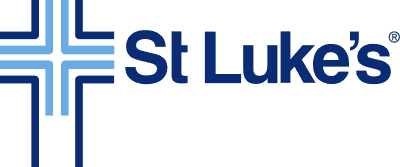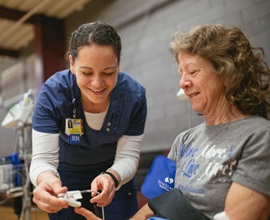
Seven St. Luke’s nurse leaders earned their NE-BC. From second from left to right: Tammy McFarlane, BSN, RN, NE-BC, administrative supervisor; Jen Smith, BSN, RN, NE-BC, nurse manager, ICU/Tele; Terri Gardner, BSN, RN, NE-BC, nurse manager, Surgical Services; Losa Manuokafoa, MSN, RN, NE-BC, director of patient care, St. Luke’s Nampa, St. Luke’s Fruitland Emergency Department, lab and radiology; Jeralie Fairbanks, BSN, RN, NE-BC, nurse manager, Women’s Services; and Charmaine Rausch, MSN, RN, NE-BC, assistant nurse manager, Women’s Services. Pictured with (far left) Misty Robertson, DNP, RN, FACHE, St. Luke’s Nampa COO/CNO and (far right) Elizabeth Steger, MSN, RN, NEA-BC, FACHE, senior vice president, clinical practice integration/chief nurse executive. Not pictured: Zachary Carter, BSN, RN, CCRN, NE-BC.
Nurse Leaders in Nampa Form Study Cohort, Earn Board Certifications
As patient counts stabilized after the worst of the COVID-19 pandemic, teams worked to refocus priorities. With the support of Nampa’s CNO/COO Misty Robertson, DNP, RN, FACHE, a group of nurse leaders in Nampa got together to form a Nurse Executive/Nurse Executive Advanced – Board Certified (NE-BC/NEA-BC) study cohort.
Earning a NE-BC or NEA-BC, national certifications offered through the American Nurses Credentialing Center, demonstrates the knowledge and skill of nurses working in leadership roles. The leaders interested in earning these certifications understood the challenges of studying and preparing for a certification exam while also managing day-to-day operations, so they elected to form a study group to encourage each other and stay on track.
For many of these leaders, board certification had been a personal development goal for years. The group scheduled a weekly study group via Microsoft Teams®, gave each other homework assignments and worked through practice questions together. The meetings were also recorded, so if some participants missed a session or wanted to re-listen to the meeting, they could.
The group learned together, shared study materials and test-taking tips, and acted as each other’s cheerleaders. By the end of 2023, Nampa had seven nurse leaders complete their certifications.

Elmore Emergency Department Nurse Advocates for New Equipment
In 2023, Wendy Vanderburgh, MSN, RN, NREMT-P, FP-C, assisted St. Luke’s Elmore Emergency Department in applying for a St. Luke’s Children’s grant.
Annually, a portion of the proceeds from St. Luke’s Children’s advisory board fundraising is allocated to the Children’s Quality and Safety Fund. St. Luke’s medical staff, employees and volunteers can apply for these funds.
Wendy completed the application, requesting a new baby warmer for the Emergency Department. Wendy identified that babies are not as adaptable to temperature changes as adults are, and during the rapid assessments that happen in the ED, infants can become cold-stressed, causing them to use more energy and oxygen to create warmth. As a critical access hospital, infants who need additional support might have longer wait times for transfer; it can take up to 45 minutes before the St. Luke’s Maternal Child (also known as MatCh) team arrives. These findings underscored the ED’s need.
The approval of the funds led to the ED receiving a new panda warmer,
improving quality care to our smallest patients.

St. Luke’s McCall Opens New Hospital and Urgent Care To Serve the Growing Community
The St. Luke’s McCall new and expanded hospital opened July 18, 2023. Planning for the two-story, 50,000-square-foot hospital expansion began in 2015. Construction began the summer of 2019.
The McCall team had maximized every space and squeezed every bit of efficiency out of the hospital, which had been remodeled, renovated and remodeled again for decades. The region has grown continually in recent years, leading to increased demand for health care services.
With the new expansion, St. Luke’s has brought the hospital into the 21st century and ensured that it can continue to provide the high-quality, convenient care the people of the McCall community deserve. And although medicine, technology and science have evolved considerably, what hasn’t changed is the value of having the “Right Care, Right Here” in McCall.
The hospital expansion has been guided by one fundamental priority: the needs of its patients. The design was created in consideration of evidence-based practices and promotes quality care, safety, efficiency and a healing environment.

“I’m so proud of our team, and I appreciate everyone’s commitment,” said St. Luke’s McCall Chief Operating/Chief Nursing Officer Amber Green, MSN, RN. “It was a real balancing act to ensure we were providing the best care for patients in our current space while preparing to move into the new hospital.”
In addition, the new St. Luke’s Urgent Care in McCall opened Aug. 8, 2023. The clinic is for walk-in care only and operates seven days a week from 8 a.m. to 8 p.m.
While assessing the need for an urgent care clinic in 2020, the team reviewed the types of cases seen in St. Luke’s McCall Emergency Department. The data revealed that more than 45% of the 6,538 ED visits in 2019 were considered “less urgent” and could have been handled by an urgent care clinic.
Projections anticipate serving 8,000 people per year in the urgent care clinic, increasing capacity by an additional 2,000 visits per year compared to the number of patients previously seen in McCall’s same-day appointment clinic.
Download Full Copies of Our Nursing Annual Reports








